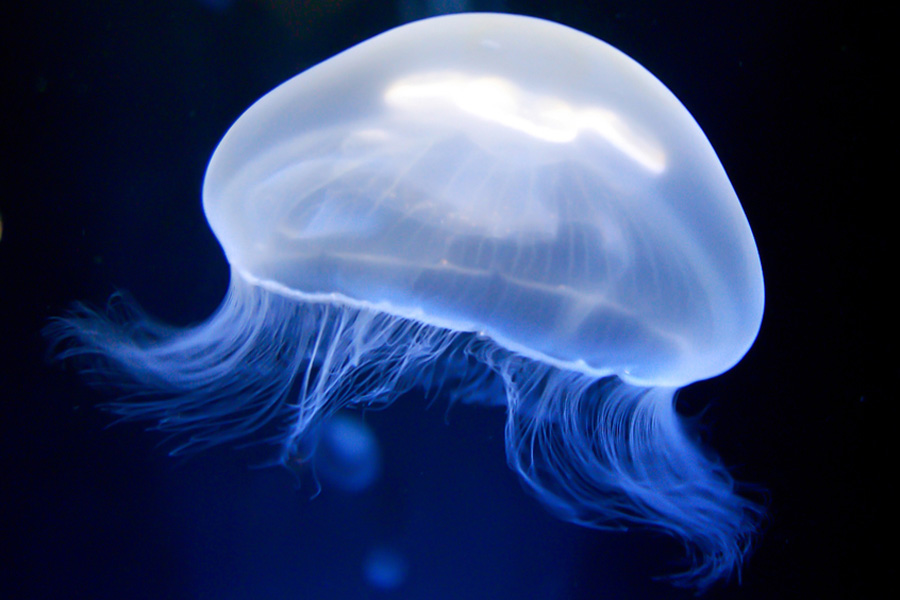It is jellyfish season at our local beaches, but that should not prevent you from enjoying a quick surf sessions. Here is everything you need to know about our local jellyfish and how to deal with a jellyfish sting.
You can contact ocean rescue for beach conditions daily by calling the following number (954) 480-4413 or check the city website here.
It is quite unbelievable that Jellyfish make their way across vast expanses of the ocean without so much as a brain or nervous system to guide their path. The main jellyfish we are currently seeing off the coast is commonly known as the moon jellyfish and is known to be harmless. Still, spotting one near you in the surf can still get your adrenaline pumping.
The Aurelia Aurita or Moon Jelly

The Aurelia Aurita, known as the moon jelly, is the most common and widely recognized jellyfish species. Though it has venom, it is harmless to humans—it’s even a popular dish to eat in China!
The umbrella on the Aurelia Aurita can reach 30 to 40 centimeters, with marginal tentacles and gonads arranged in four circles. There are four long oral arms in the manubrium.
It lives in all oceans of the northern hemisphere and is very abundant. This jellyfish is also often seen in public aquariums across the globe.
Characteristics and Features:
- Mild sting with harmless venom
- Clear and transparent
- Around 5 to 40cm wide
- Saucer-shaped umbrella head
- Short, stinging tentacles and gonads in four circles
- Four long oral arms
- Abundant in most oceans and coastal waters
- Can withstand freezing water (up to -6 degrees Celsius)
Moon jellyfish ( Aurelia aurita) are found in nearly all the world’s oceans, primarily in inshore regions like harbors and estuaries. Because its locomotion is rather limited, this species prefers temperate waters with regular currents that can help push it through the water column. The moon jelly feeds on plankton using the tentacles flowing from the bell, and is not harmful to humans.
JELLYFISH STINGS
Jellyfish typically follow warm waters and since we live in South Florida, tropical sea-life is just part of the experience. Jellyfish have been recently making their way onshore due to offshore tropical winds pushing them closer to the beach.
WHAT TO DO IN THE EVENT OF A JELLYFISH STING
Rinse the wound with sea water. DO NOT use fresh water.
Deactivate the remaining cells with vinegar over a 30 minute period.
Remove any remaining tentacles with forceps or a gloved hand. DO NOT rub the area. If you anticipate anaphylactic reactions, call 911 if necessary.

While jellyfish stings hurt, the good news is they are, for the most part, not life threatening. Here are a few tips to help you:
1. Rinse the wound off with natural sea water
Another item to include in your beach bag is a pair of tweezers. In the event of a jellyfish sting, carefully pluck away the visible tentacles with tweezers. Do not scrape the tentacles off with sand or any other object because this could trigger any active tentacles to release more venom
2. Apply Vinegar to the Sting
When packing your beach bag for the day, it may be smart to include a small bottle of Stream to Sea in case you or someone else gets stung by a jellyfish. (You may just end up being the hero in the event someone else gets stung and you have vinegar!) Douse the stung area with vinegar. This will deactivate the stinging cells and rinse away any extra tentacles, which will prevent the stinging cells from spreading. If you do not have vinegar, just head up to the lifeguard stand.
3. Gently Pluck Away Visible Tentacles
Another item to include in your beach bag is a pair of tweezers. In the event of a jellyfish sting, carefully pluck away the visible tentacles with tweezers. Do not scrape the tentacles off with sand or any other object because this could trigger any active tentacles to release more venom.
4. Soak the Skin in Hot Water
Lastly, you should soak the skin as soon as possible in water heated to 110 to 113 degrees Fahrenheit. If you don't have a thermometer, simply test the water by hand. It should feel quite hot to the touch, but not scalding. You should soak the sting in the water for 20 to 45 minutes.
While the above tips work for most jellyfish stings, you should consult a doctor if the sting worsens or you display symptoms of an allergic reaction.
There is a chance that you could potentially have been stung by a Man O' War, which can cause stings to be more severe. In most cases of a jellyfish sting you can treat pain and inflammation with an oral pain killer and antihistamine.
Don't let the fear of a jellyfish keep you from catching waves or enjoying a day at the beach. While a jellyfish sting can dampen your day, it shouldn't ruin it.
READ MORE:
3 Ways to Prepare for Man-o-War Season



